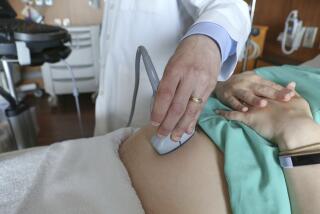New Women’s Health Complex Is Long-Awaited Remedy for Barrio
- Share via
The Logan Heights Family Health Center, which began on National Avenue 19 years ago as the Chicano Free Clinic, officially dedicated its new women’s center Friday, a facility designed for low-income and indigent women who have few options when it comes to health care.
Laura Rodriguez, the 80-year-old matriarch and founder of the center, who keeps a hand in its day-to-day operation, said the Women’s Health Center is a long-awaited “miracle” and an answer to a community plea.
In less than two decades, said Fran Butler-Cohen, executive director of Logan Heights Family Health Center, the center has evolved from a small operation seeing about 150 patients a month to a booming outpatient facility treating more than 70,000 people a year.
Badly Needed
“I never dreamed it would get this large,” said Rodriguez, who took over the center in 1970 in a 59-year-old building in the shadow of the San Diego-Coronado Bay Bridge.
“I’ve lived here (in Barrio Logan) all my life,” she said. “My father was a blind man, and I don’t ever remember going to a doctor. So I know the center was badly needed.
“When I open the doors at 7:30 a.m., everybody’s out there. We get blacks, Asians and whites--just a tremendous amount of people.”
The demand for health services in Barrio Logan and the inner city is so great that even the new clinic won’t be able to accommodate the crush.
Butler-Cohen said the new, 12,000-square-foot clinic, which began treating women last week and will have a price tag of about $700,000 when completed, came about through an intense, two-year fund-raising effort.
Tom Page, chairman of the board of San Diego Gas & Electric Co., headed the drive, and SDG&E; itself contributed $120,000, Butler-Cohen said. Some money came from the city of San Diego through federal Community Development Block Grants, but she noted that less than 20% of the annual $6-million operating budget will come from governmental subsidies.
The health center has doubled its exam rooms from four to eight, Butler-Cohen said, and the first floor will eventually house a birth center.
Services Disappeared
A special program will give women access to social services, nutritional counseling and other baby-related offerings.
“We’ll be providing the obstetrical and gynecological services with eight exam rooms and a special procedure room,” Butler-Cohen said. “Those services are pretty much dried up in San Diego County for low-income women.”
A special focus will be given to pregnant women with drug or alcohol dependency.
“If you’ve seen neonatal intensive-care units, it would boggle your mind. These babies are going through withdrawal, and it’s pretty frightening.”
Such help is needed before babies are born, she said. Otherwise, the cost will be borne in hospital fees, primarily in intensive-care units.
“The upshot is that, if you can’t take care of the babies before they’re born, then they’re going to cost the taxpayers a tremendous amount of money when they’re in the hospital,” Butler-Cohen said. “One baby that goes in a newborn intensive-care unit costs an average (of) $19,000. That means that, after the child comes out of ICU and is not all right, he will be cared for by the taxpayer for the rest of his life. I’m talking residential, medical and psychological care, and housing.”
Butler-Cohen said the new women’s clinic is now the largest provider of perinatal care services in the inner city.
To receive subsidized care at the center, women must document that their income falls below government poverty guidelines.
Even so, directors say, the clinic will strive to emphasize treating those people with dignity.
“There should be no difference between a clinic in La Jolla and ours,” Butler-Cohen said. “Just because you’re low-income doesn’t mean you have to come to a shabby place.”
More to Read
Sign up for Essential California
The most important California stories and recommendations in your inbox every morning.
You may occasionally receive promotional content from the Los Angeles Times.










